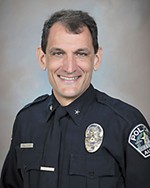Dissecting the Science of Death
1998 murder case will get a scientific examination
By Jordan Smith, Fri., Feb. 24, 2012
The question of whether the science of death and decomposition can prove that Larry Swearingen, now on death row, was not responsible for the 1998 kidnapping and murder of 19-year-old Melissa Trotter, will be taken up in district court in Montgomery County starting Feb. 27.
Trotter disappeared on Dec. 8, 1998. It was finals week at Montgomery College where she was a student; she attended a science class review and did some work on a computer in the college's library, then she disappeared. Three days later, Swearingen was arrested on outstanding warrants; he's been behind bars ever since. Although the portion of the Sam Houston National Forest where she was ultimately found had been searched several times, by both law enforcement and others, her body was not discovered until Jan. 2, 1999. Swearingen was subsequently charged and convicted of capital murder and sentenced to die.
At issue, however, is whether science actually proves Swearingen's innocence. According to Swearingen's defense attorney James Rytting and a bevy of medical experts – including a number of well-respected Texas medical examiners – it is impossible for Trotter to have been dead for more than a few days when her body was found. And if she had been dead for less than a week, Swearingen could not have been the killer because he was already in jail. Specifically at question is whether Trotter's body displayed the kind of decomposition expected of a body left outside for several weeks in the forest in December. According to evidence first provided to the defense in 2009, the answer is no; histological samples of Trotter's heart, lung, and vascular tissue is more consistent with a person dead mere days before she was found.
The state, however, says the evidence presented by the defense is not the best science to use to determine how long Trotter had been dead. Montgomery county prosecutor Warren Diepraam in late January filed with the court a list of three experts he intends to call during the evidentiary hearing – experts who the state apparently believes can prove Trotter's time of death as concurrent with her disappearance in early December. The state says it will call two forensic entomologists and an out-of-state pathologist, who in 2009 told the state that he concluded Trotter was killed in early December in part based on a decade-old finding that food found in Trotter's stomach was "consistent" with the last food she was seen eating at the college. Others who have viewed photos of the stomach contents say they look not at all like the french fries she was known to have consumed. Moreover, using stomach contents to determine time of death is not exact – indeed, it was among the questionable evidence used to convict Michael Morton for the bludgeoning death of his wife; Morton spent nearly 25 years in prison before being released last year, when DNA evidence linked the murder to another man.
Moreover, the qualifications of at least one of the bug experts the state says it intends to rely on appear, at face value, not entirely relevant to the Trotter case. In addition to Dr. Neal Haskell – a Saint Joseph's College professor who says in a college bio that he was an inspiration for the TV show CSI: Crime Scene Investigation – the state has notified the defense that it intends to call Sam Houston State University professor Sibyl Bucheli, whose research focuses primarily on moths and butterflies; there is nothing in her curriculum vitae to suggest she has relevant forensic experience.
Nonetheless, the state says it has also consulted with a number of other scientists – including a forensic pathologist, a forensic anthropologist, an agronomist, an additional entomologist, and a professor of "urban nutrient and water management" – all of whom the state says agree with the conclusions of its primary experts. For more on the Swearingen case, see "The Science of Injustice," Aug. 19, 2011.
Got something to say on the subject? Send a letter to the editor.











